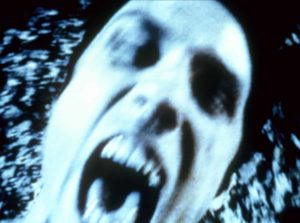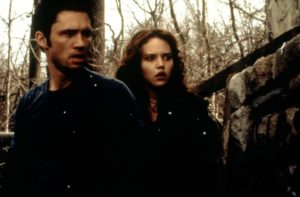Happy All-Hallow’s Month! In anticipation of Halloween — which, let’s face it, we’ve been anticipating since last Halloween — Daily Grindhouse will again be offering daily celebrations of horror movies here on our site. This October’s theme is horror sequels — the good, the bad, the really bad, and the unfairly unappreciated. We’re calling it SCREAMQUELS!
And if you like this feature, please check us out on Patreon for unique reads and deep dives! Just $3 a month gets you everything! All treats, no tricks.
Belief is a dangerous thing.
In 1692, belief caused the village leaders of Salem, Massachusetts to accuse more than two-hundred people of witchcraft. They executed twenty of those people, nineteen by hanging and one by pressing, believing that they were in league with the devil himself.
Belief led the congregants of the Peoples Temple to move to the jungles of Guyana in 1974. Four years later, that same belief caused their leader, Jim Jones, to order the poisoning of nine hundred and eighteen of those congregants, including almost three hundred children.
Belief led Tex Watson, Susan Atkins, Patricia Krenwinkel, and Linda Kasabian to the home of Sharon Tate in Benedict Canyon. Belief ingested the phenobarbital and placed the plastic bags over the heads of the members of Heaven’s Gate in 1997. Belief led a cabal of simple-minded baboons to storm the halls of Congress in January of 2021.
It’s the most powerful magic the world has ever known. It can warp reality to fit any set of ideological principles. It can confuse you, direct you, and make you do horrible things to yourself and others.
It convinced Heather Donahue, Josh Leonard, and Mike Williams to make a documentary film in the woods surrounding Burkittsville. Then, a few years later, it brought together a disparate group of tourists who so badly wanted to feel its power that they lost touch with their realities.
This idea, that belief can change reality itself, is what Joe Berlinger wanted to explore in his debut horror film, BOOK OF SHADOWS: BLAIR WITCH 2.
And I’m here to tell you that he absolutely succeeded.

***
“The film with which we are left is arguably one of the most disappointing horror sequels of all time.”
“A punishing leap backward.”
“An abomination.”
“A peerless indignity, a club-footed vomit launch of teen-horror cliches, overproduced self-importance, and scare-less gore.”
These are just a few of the scathing reviews left by film critics after they screened BOOK OF SHADOWS: BLAIR WITCH 2. If you spend a few minutes scrolling down the aggregated reviews on Rotten Tomatoes, you’d come away thinking that Joe Berlinger and Artisan committed a human rights violation back in October of 2000 when they released this follow-up to the indie darling-turned-blockbuster original.
And you might be right.
BOOK OF SHADOWS is NOT a good movie. It’s not the worst thing to happen to America in the early 2000’s like some of those critics might make you think, but it is still a no good, very bad movie.
But that’s not all it is.
It’s also the perfect sequel to THE BLAIR WITCH PROJECT.
***

In November of 1999, a group of BLAIR WITCH fanatics descended upon Burkittsville to take part in a “group tour” of the different locations featured in the film. Led by Jeff, a former psychiatric patient and kleptomaniac, the group camps and gets belligerently drunk in the ruins of Rustin Parr’s house.
Graduate students researching mythology and mass hysteria, Stephen and Tristen, psychic goth-queen Kim, and an annoying wiccan named Erica round out the group of merrymakers. After getting thoroughly shitfaced on the grounds where eight children were murdered, they black out and wake up to the wreckage of their campsite. All that remains are the tapes of the previous night, which they decide to examine over at Jeff’s awesome factory-house.
To avoid spoilers, let’s just say that thing don’t go great for the group after that first night. There’s murder, sexy belly scratches, counterclockwise prancing around a tree, some phantom children walking backwards, and some spooky dogs that show up and then disappear for no reason. After fully losing their shit, the group is brought down to the police station to answer for the crimes they committed on tape.
The movie is an examination of what happens when the line between truth and fiction blur. It’s a flawed look at the dangers of belief and what the human mind can create when fear and delusion are combined. It’s not a good movie, as we’ve already established, but it’s a prescient glimpse at how fluid reality can be when belief and devotion is focused on a singular point.
***
Think about your favorite letter. Mine is probably “T” because it’s the first letter of my name. The actual letter itself is meaningless. It’s just two strokes of the pen, one vertical and one horizontal, but when you couple it with the meaning it represents (Tyler, the person), it suddenly is imbued with immense power.
In BOOK OF SHADOWS, the foundations of Rustin Parr’s home are littered with symbols. Erica the wiccan describes these marking as being from “an ancient witch’s language”. After their drunken night, these symbols begin to pop up on their skin like rashes. This, according to Erica, means that they have been “marked” by a witch, and that they will be the next to die.
The problem with this is that those symbols have nothing to do with witchcraft. They’re basic runes from the Elder Futhark alphabet. They’re Norse, so that does make them pagan, but there’s nothing sinister about them at all. Stephen has two visible runes on him, the Algiz (which is a symbol of protection) and Thurisaz (which denotes unconscious forces and hardship), meaning that his symbols could give him protection from psychological hardship. Goth-queen Kim has the Nauthiz rune on her shoulder, which gives the invoker the ability to understand what must be done in complex situations. Erica, the one who claimed that these symbols were an ill-sign in the first place, also had Thurisaz (unconscious forces) on her body, which was coupled with Kenaz, which gives a person clarity, insight, and the ability to transform.
In the context of the film, these symbols are gibberish. They might have just looked cool to Berlinger and co, but their inclusion is a fitting metaphor for the power of belief.
What gives them their power is the group’s belief in their negativity. When you take these Nordic runes and concentrate on them with the belief that they are evil signs of your imminent death, they become more powerful than you could ever imagine. In that way, they become real.
This happens in real-life, too. In 2014, three teenage girls were walking in the woods near Waukesha, Wisconsin. Two of the girls had recently become obsessed with the image of Slender Man. They devoted their entire lives to looking at pictures of the gangly creature and imbued them with the idea of their physical and psychic release. They became convinced that they were to become proxies of Slender Man, and in return he would take them to his mansion in the woods and care for them for the rest of their lives.
To become proxies, however, they believed that they had to make a human sacrifice. So, they led their friend into the woods, held her down, and stabbed her nineteen times in the arms, legs, and torso. Luckily, the victim survived, but she had major damage to her internal organs. The two girls were found walking along the highway with the bloody knife they used in one of their bags. Both believed that it was a necessary act that had to be done so that they could leave their lives behind and become one with Slender Man.

We all know that Slender Man is a fictional character created for an online photoshop contest back in 2009. He is not real, but when those two girls poured their entire psychic power into his image, he became just as real to them as Jesus or any other religious figure. They gave him life by believing in him. The same is true of the Blair Witch. Joe Berlinger’s BOOK OF SHADOWS tackles this by making us question whether or not the witch in the woods existed at all.
For me, a highlight of the original film is that we never actually see the Blair Witch, or Rustin Parr, or any of these phantom antagonists whatsoever. We never actually see anything supernatural happening, but it’s so heavily implied that almost everyone who watched it came away thinking that the myths and legends of Burkittsville were true.
What if they aren’t, though?
What if all the events of the first film were perpetrated by none other than Josh, the long-haired camera hunk who disappeared from the camp site? It’s his screams they follow through the woods. It’s a piece of his shirt Heather unwraps to find blood and teeth and finger. We never see who strikes Heather in the basement. We never see who is making Mike stand in the corner like a good little boy. Instead of it being the witch or her henchman Rustin Parr, what if it was just Josh, afflicted with the mania of fear and the disease of belief?
This is the thread Berlinger tried to pull on with BOOK OF SHADOWS. What if there is nothing truly supernatural happening at all in those woods? What if these tourists, deluded with a deceitful marketing strategy and a desperate hope to experience something spooky-scary, pour their psychic energies into the symbols and images of the witch and go on to commit these heinous acts of violence on one another? The end sequence and corresponding video evidence seems to point in this direction.
We all grew up seeing the BLAIR WITCH franchise as a story about Elly Kedward, her mistreatment by the townspeople of Blair back in the late 1700’s, and her return as a supernatural being to exact her revenge on those who dare trample in her woods. Berlinger’s sequel, even with all its warts, paints a much more terrifying picture than that.
He shows us the danger of belief. Much like the letters of an alphabet, fictional characters can become very real when they are combined with the meaning and symbolism of the things they represent. Slender Man was just a computer image on a message board until two girls gave him life by spilling the blood of their friend. The Blair Witch was just a myth until Heather, Josh, and Mike gave her life through their documentary and deaths. This new group, led by tour guide Jeff, believed in her so much that their realities soon became warped, broken, and deadly.
There’s a term for these types of thought-forms who take on a life of their own. Buddhists familiar with the Vajray?na call them tulpas. They believe that if you devote enough of your spiritual and mental powers to a fictitious being (sometimes focusing these thoughts using symbols), the being will become alive. The reality surrounding these tulpas will change, allowing them to think, feel, and have complete personalities of their own.
Is that what the Blair Witch is? A tulpa created from the fear and belief of those who saw the original film?
Berlinger didn’t make a good movie, but he did make a movie that forces us to think about what we are giving power to in our own lives. What boogeyman are we imbuing with our absolute belief? Is it an international group of child molesters operating from the basement of a pizza parlor? Is it a nefarious government putting microchips in our vaccines, or stealing an election from the true patriots of America?
As January 6th, 2021, showed us, when you pour enough belief into nonsense, the tulpa you create can have disastrous effects. If you portray a fictional film as being real, like Artisan did with THE BLAIR WITCH PROJECT then will the corresponding public belief in that realness then make it real? That’s what Berlinger was showing us, and it makes for one of horror’s most perfect sequels.



No Comments